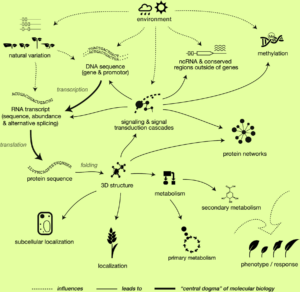Highlights of plant science 2017. Jul-Aug
The last week of the year is the time to look back and reflect. We like to take this opportunity to recognize the good work done by the plant science community. Over the next few days we’ll remind you of some of the big stories and successes that came from our community. These stories were highly accessed through the ASPB and Plantae.org blogs, our many social media sites, and our journal websites. We hope you enjoy this look back at what has been an eventful and productive year in plant science. Check out the highlights from the first part of the year here, here and here.
 A suite of pigment papers kept us busy and got lots of coverage in the media in July and August, from the true-blue chrysanthemum (Noda et al.) and blue rice endosperm (Zhu et al.) to the antimicrobial properties of betalains (Polturak et al.). Read more about this colorful research.
A suite of pigment papers kept us busy and got lots of coverage in the media in July and August, from the true-blue chrysanthemum (Noda et al.) and blue rice endosperm (Zhu et al.) to the antimicrobial properties of betalains (Polturak et al.). Read more about this colorful research.
 In other research news, Waese et al. introduced ePlant: Visualizing and Exploring Multiple Levels of Data for Hypothesis Generation in Plant Biology. This database (http://bar.utoronto.ca/eplant) integrates genome, proteome, interactome, transcriptome, and 3D molecular structure data. It’s your source for everything you need to know about your favorite Arabidopsis gene or protein, and the code can be used for other species.
In other research news, Waese et al. introduced ePlant: Visualizing and Exploring Multiple Levels of Data for Hypothesis Generation in Plant Biology. This database (http://bar.utoronto.ca/eplant) integrates genome, proteome, interactome, transcriptome, and 3D molecular structure data. It’s your source for everything you need to know about your favorite Arabidopsis gene or protein, and the code can be used for other species.
Other hot papers included Taniguchi et al. who wrote about how the Arabidopsis LAZY1 family contributes to gravity signaling, and Pini et al. who presented a method for using bacterial biosensors for in vivo spatiotemporal mapping of root secretion; at last we can eavesdrop on the conversation between plants and their partners. A Policy Forum by Reynolds et al. addressed how best to integrate crop research for future breeding efforts, in the form of a Global Crop Improvement Network.
July and August saw a flurry of multimedia excitement, including the launch of the Taproot podcast, “a new podcast that digs beneath the surface to understand how plant science publications are created,” with hosts Liz Haswell and Ivan Baxter. If you missed it, you can still download all of the Season 1 episodes. Keep your ears open in early 2018 for the launch of Season 2!
We also saw some wonderful videos released. Molly Edwards is a graduate student at Harvard who in her spare time creates high-quality YouTube videos about plant science (she has also received support from ASPB through a BLOOME award). Check out her YouTube channel, and a Plantae seminar in which she describes the big picture and small details about how she produces these videos. In August she released a video (embedded below) in which she interviews scientists at the Van Eck Lab at the Boyce Thompson Institute to learn how genetically-modified plants are made.
August also saw the release of a beautifully animated video, part of the TED-Ed series, on how plants defend themselves.
Join us tomorrow for highlights from September and October!



